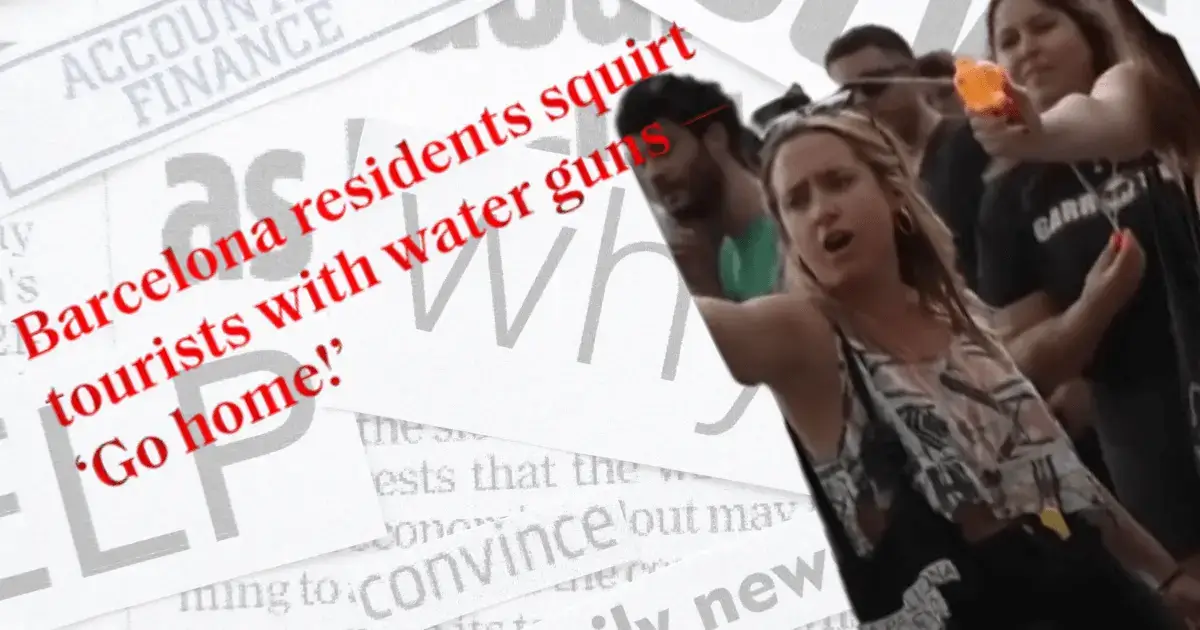Tourists on the hot shot !
But it is the protests that are emerging in several European cities against tourists that deserve more attention. What started out as few-and-far-between occurrences in pockets of cities a year, now has become an increasingly pervasive protest motivated by community frustration over housing shortages and the demand to keep neighbourhoods liveable for long-term residents. At a local level, we can observe several cities such as in Southern Europe where the inhabitants seem to be fed up of mass tourism and are lashing out. The message for many now: go home — a feeling that hints at the larger issues facing cities balancing tourism with their citizens.
Incidents Sparking the Backlash
The first high-profile filled in Italy-especially tourist hotspots like Rome and Venice. Italy is one of the biggest tourist destinations in the world, attracting millions who want to visit historic sights such as the Colosseum and canals of Venice or go shopping in Milan. This massive movement of tourist is to be understood but over time it started deteriorating the cities.
The Italian government for a while has issued two bans — one to counter overcrowding and another aiming at preserving cultural heritage, banning sitting on antique staircases, as well taking selfies in defined locations. Iconic steps in cities such as Rome, like the Spanish Steps, closed to tourists who may have been looking for a rest or snapping that perfect photo. The decision to keep the block in place was taken, he said ‘to safeguard the public from’]);
Escalation in Spain: Barcelona’s Struggle with Tourism
In Barcelona, the resentment burst out on to the streets when demonstrators marched with water pistols and hoses against tourists ordering them to leave. Restaurants and cafes were deserted by visitors, many of whom fled while eating to escape being trapped in the violent protests. While it is easy to dismiss these things as harmless pranks, the truth runs deeper — locals are at boiling point on how their lives have become a drag thanks to mass tourism.
Many of the protestors articulated a feeling that tourism was so lucrative it drove them out. Increased property investment in reaction to a growing Airbnb-based vacation rental industry is blamed by many Barcelona residents for squeezing city housing prices beyond their reach. Locals who once inhabited the city-centre are now being priced out to its peripheries, as investors cash in on a tourism goldmine. Protestors from around the coastal city insist that locals need to come first and they want Barcelona council to gain a grip on homes before it gets out of control.
The Global Spread of Anti-Tourism Sentiment
Anti-tourism protests are not just a problem in Italy and Spain: It is now more than ever before, an international phenomenon. Backlash against tourists in Europe: similar battles are brewing across the continent and cities like Amsterdam, Dubrovnik or Paris are also slowly starting to have enough of tourism. The underlying causes are diverse but relate to common symptoms — the increased burden that tourism is putting on local facilities, a glut of holiday lets pushing up property prices and a declining sense of community.
Perhaps the single largest issue espoused by anti-tourism advocates is related to tourism’s effect on housing. Short-term vacation rentals A major consequence of big tourist dollars flooding cities is an increase in demand for short-term rental units — perfect opportunity to flip your home into quick cash-spitting’ vacation property. The downside of these increases is that rents and property prices also shoot up, making it more difficult for locals to find affordable housing. Home prices driven by a wave of tourism-related real estate are pushing long time residents out in frustration and anger as their cities fall into the hands of people who reside elsewhere for most or all of the year.
Furthermore, many cities are finding that their infrastructures just were not made for this massive influx of tourists. Millions of visitors overwhelm public transport systems, healthcare facilities and sanitation services that were designed for small local populations. A common gripe is that local residents are being ignored in order to service tourists.
Cultural Erosion and the Displacement of Locals
Also a major complaint among host populations is that tourism creates cultural erosion. Tourism has commodified local culture in a plethora of historic cities around the world. Residents lose restaurants, shops and markets that once served them — to be replaced by souvenir shops, chain retailers and open-air cafes aimed at tourists. As tourists take over these cities, the local businesses that have managed to hang on as long they could are slowly vanishing and taking with them any character or authenticity that remains of those particular corners.
Beside the commercial move, a local displacement is occurring; in physical an emotional sense Locals can no longer use public spaces simply because when tourists come, their cities are overcrowded. It fills up with tour groups and often edging-out the locals, who instead tend to work in the percent of Rio that is not included on your guided experience.
What Needs to Change?
The authorities have a duty to protect the world’s cultural treasures, but they also need to listen when Rome and Venice manage more passengers than residents — this is not just frustration at work here, it is an SOS from populations who are feeling trampled on. This is a clear message from these cities: tourism must be intentional and tempered with consideration for the permanent residents of those places.
A possible solution is to improve regulation of short-term rental properties. Municipalities are required to limit the number of homes that can be short-term rented out so as not only locals have a place where they end up paying double them or else will go nuts. Berlin, for example, has made it illegal to rent a whole property on Airbnb and similar sites more than once every two months. Such measures should be adopted in other European cities and in other parts of the world too.
Conclusion
The recent spate of anti-tourism protests sweeping across Europe should serve as a wake-up call for cities hungry for tourism revenues. At the same time, tourism can be a devil disguised as an angel — and one of its unintentional effects is damage to cities Proudfoot Tourism efforts should not only celebrate but also protect our urban canters. It is key to find a balance between the soaring amount of tourists and keeping intact the cultural heritage as well as quality of life for its citizens. Unless there is foresight and planning, Rome, Venice and Barcelona may be the first of many more cities to one day have locally-driven cause for a little harmed place.
What are your views about it ? How can be this situation better be tackled ? Tell us your views about it in comments section below.





Comment (0)